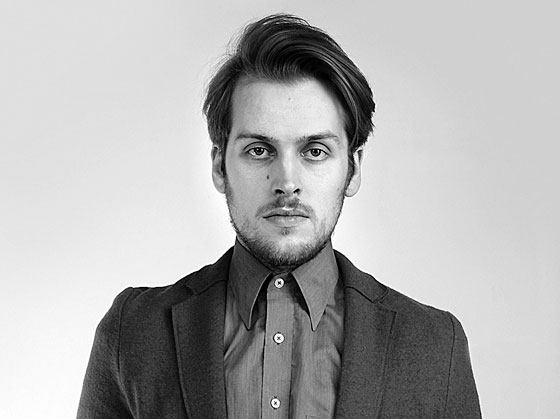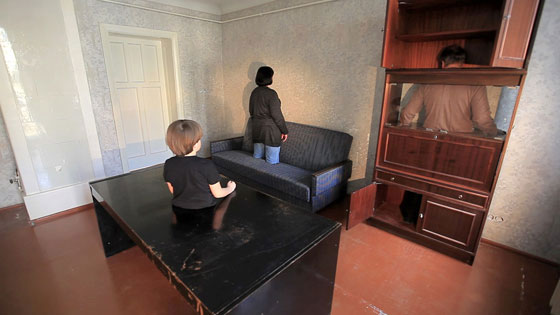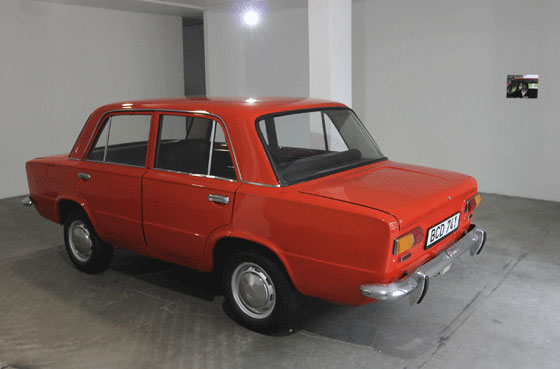|
|
| Indriķis Ģelzis Santa Mičule, Student, Art Academy of Latvia | |
| Artist Indriķis Ģelzis (born 1988) graduated this year from the Department of Visual Communication of the Art Academy of Latvia with a Bachelor’s degree, and he now continues his studies in the Master’s programme. Up to now, Ģelzis has had three solo exhibitions; he has taken part in many local and international group shows and art festivals, and also received a commendation at the 10th International Contemporary and Video Art Festival Ūdensgabali (‘Waterpieces’). | |
 Indriķis Ģelzis. 2012 Photo from the private archive of Indriķis Ģelzis | |
| Even though Indriķis Ģelzis does not wish to limit his creative output to video art only, it must be acknowledged that he is one of the more prominent artists of the younger generation who, in a short time, has left an impressive mark on the art scene. Ģelzis’ video works often make use of the principle of collage – the action takes place simultaneously or consecutively across several screens. This strategy expands the framework of the space and time of a work of art, and also transforms it into an attractive spatial installation. To a certain extent, Ģelzis’ audio-visual installations incorporate also elements characteristic of photography. These are evident in both the visual harmony of the scenes as well as in the meditatively slow movement of the frames, almost as if held at a standstill, which requires a viewer with patience and the capacity to wait and concentrate. It cannot be denied that the artist has an aptitude for manipulating with the possibilities of video technology, yet the main focal point of his ideas is in the performative stagings, dealing with issues that are important to the artist – most often about the seemingly self-evident, but at the same time paradoxical, relationship between the human being and the surrounding world. The common point of contact for both is a person’s con-sciousness, and the peculiarities of human perception are the starting point for many of Ģelzis’ works. | |
 Indriķis Ģelzis. Changeover. Video still. 4’50”. 2011 Publicity photos Courtesy of the artist | |
| Indriķis Ģelzis’ range of interests and characteristic artistic techniques were revealed particularly vividly in the exhibitions at kim? Contemporary Art Centre (Aklās skaņas (‘Blind Sounds’), and Tikšanās (‘Meeting’)), and at this year’s Cēsis Art Festival. In ‘Blind Sounds’ the artist brought to visual life his realization, arising from personal contemplation, that sound and image are impalpable and hard to identify phenomena. This revelation was implemented in the video work by means of the poetic meditation formula typical of Zen Buddhism or Zen Koans: an unanswerable question based on paradox, which proves the inadequacy of formal logic in understanding the world. By creating an odd hybrid-sculpture of a musical instrument and a live human being, these images serve as illustrations for the realm of hearing and sight, or of that moment in the consciousness when both hearing and sight can be perceived as one whole. But the core idea of the work is in the artist’s contemplation about a state of awareness where it might be possible to perceive the separate states of image and sound, and to be able to feel them as separate physical substances. The works displayed in the exhibition ‘Meeting’ were also linked by a similar conceptual approach. Here the artist had played on a sensation that we all know, that of spatial displacement when there are two simultaneous movements in opposite directions, for example, when we are in a fast-moving car and watching the landscape passing by. This was explored both in video stagings, as well as an unusual auto-installation made out of the rear parts of Lada cars. The loss of coordination was presented as a broader metaphor for a lack of equilibrium in the social or spiritual domains. This was also hinted at by the miniature video screens mounted on the walls of the exhibition hall, showing well-known road rules as depicted by road signs, and where the “protagonists” and the carriers of meaning gradually faded away into nothing, thus causing the rules and points of reference to disappear as well. In the work Pārmaiņa (‘Changeover’) (commended at the 10th International Contemporary and Video Art Festival ‘Waterpieces’) Ģelzis presents illusion as something that has actually happened, approaching techniques of montage characteristic of the imagery of surrealism. The narrative of the video work is a musing about “the nature of things and human beings”, which is visualised as their fusion into one image: as in ‘Blind Sounds’, people were montaged into furniture, creating a grotesque and alien atmosphere. The artist created the illusion of stripping down the borders between the possible and impossible, conveying a message about the singular way that people tend to grow into those things, circumstances and conditions which we are used to setting apart from our individuality as being foreign and otherwordly. | |
 Indriķis Ģelzis. Meeting. View from the exhibition. 2012 Publicity photos Courtesy of the artist | |
| The ironic wit with which Indriķis Ģelzis plays out various absurdities, which are caused to be absurd because of our customary perception of things, makes his works pleasantly refreshing. The works challenge a self-explanatory and an all too unambiguously interpreted perception of the surrounding world. These aspects bring to mind the insights of French philosopher Maurice Merleau-Ponty, about art as the realm which has the privilege of giving visibility to those facets of life that are imperceptible or not possible to perceive with the physical sensory organs. Merleau-Ponty’s phenomenology theories, where he praises the ability of modernist artists (especially Paul Cézanne) to depict the world as it appears in the space of a viewer’s individually configured forms, are also indirectly reflected in Ģelzis’ works, making one think about odd reincarnations of modernist ideas in the language of contemporary media (although these ideas had never completely disappeared from the stage in the first place). This is particularly strikingly evident in the group of works Apmaldīties redzes laukā (‘Lost in the Field of Vision’), on show in a solo exhibition at the photographic gallery ‘Foto prieks’ in Cēsis. These works seek to expand the possibilities of spatial experience in a work of art. In the scenes filmed by Indriķis various peculiarities of human optical perception were brought to the physically impossible, as a reflection on the incompatibility of the visible world and the authentic essence of the world, thus once again unconsciously hinting at Eastern philosophical teachings about the impalpable and illusory nature of the material world. That is, that sight, as the main means of sensory perception of this world, allows only a mediated perception of the surrounding environment, of which the visual forms always remain deceptive, changeable and dependent on the position of the viewer. Indriķis’ works clearly reveal both this distance between the perception and the surrounding world, as well as attempts to “trick” the perception by using the technologically improved possibilities of “telescopic vision”. The indicative similarities with the above-mentioned are only partial, as Indriķis Ģelzis is more interested in art as an event, as a reflection of personal experiences and feelings that each of us will recognize. The events are constructed as an investigation of various (imaginary and real) boundaries, the merging and tearing down of these boundaries, and manifested as youthful self-examination. This is indicated by the autobiographical nature of Ģelzis’ works, by his active presence rather than the artist just being there as a mere observer or narrator. Translator into English: Vita Limanoviča | |
| go back | |







